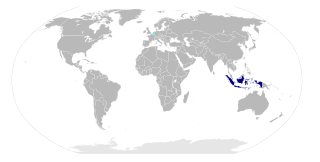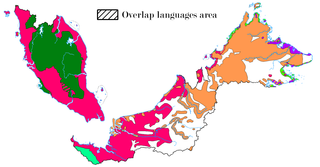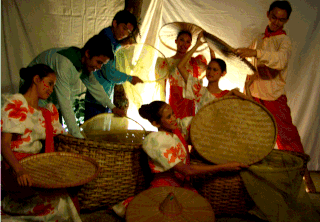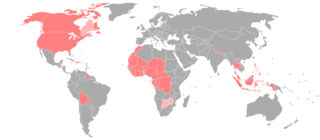
Indonesian is the official language of Indonesia. It is a standardized variety of Malay, an Austronesian language that has been used as a lingua franca in the multilingual Indonesian archipelago for centuries. Indonesia is the fourth most populous nation in the world, with over 270 million inhabitants—of which the majority speak Indonesian, which makes it one of the more widely spoken languages in the world.

Malay is an Austronesian language officially spoken in Indonesia, Brunei, Malaysia and Singapore and unofficially spoken in East Timor and parts of Thailand. It is spoken by 290 million people across the Malay world.

Jawi is a writing system used for writing the Malay language and several other languages of Southeast Asia, such as Acehnese, Banjarese, Kerinci, Minangkabau and Tausūg. Jawi is based on the Arabic script, consisting of all of the original 28 Arabic letters, and six additional letters constructed to fit the phonemes native to Malay but not found in Classical Arabic, which are.

Dewan Bahasa dan Pustaka, abbreviated DBP, is the government body responsible for coordinating the use of the Malay language and Malay-language literature in Malaysia.
Penang Sign Language was developed in Malaysia by deaf children, outside the classroom, when oralism was predominant. It is now mainly used by older people, although many younger people can understand it.
Malaysian Sign Language is the principal language of the deaf community of Malaysia. It is also the official sign language used by the Malaysian government to communicate with the deaf community and was officially recognised by the Malaysian government in 2008 as a means to officially communicate with and among the deaf, particularly on official broadcasts and announcements. BIM has many dialects, differing from state to state.
The Malaysian language or Malaysian Malay, is the name regularly applied to the standardized form of Malay language used in Malaysia. Constitutionally, however, the official language of Malaysia is stated as "Malay", but the term "Malaysian" or Bahasa Malaysia is used on official contexts from time to time. Malaysian is standardized from the Johore-Riau dialect of Malay. It is spoken by much of the Malaysian population, although most learn a vernacular form of Malay or another native language first. Malay is a compulsory subject in primary and secondary schools.
Manually-Coded English (MCE) is a type of sign language that follows direct spoken English. The different codes of MCE vary in the levels of directness in following spoken English grammar. There may also be a combination with other visual clues, such as body language. MCE is typically used in conjunction with direct spoken English.
Malay and Indonesian are two standardised varieties of the Malay language, used in Malaysia and Indonesia, respectively. Both varieties are generally mutually intelligible, yet there are noticeable differences in spelling, grammar, pronunciation and vocabulary, as well as the predominant source of loanwords. The differences can range from those mutually unintelligible with one another, to those having a closer familial resemblance. The regionalised and localised varieties of Malay can become a catalyst for intercultural conflict, especially in higher education.
e-pek@k is a project that facilitates the usage of information and communication technologies to provide the services for the hearing impaired community in Malaysia.
Kenyan Sign Language is a sign language used by the deaf community in Kenya and Somalia. It is used by over half of Kenya's estimated 600,000 deaf population. There are some dialect differences between Kisumu, Mombasa and Somalia.

Bahasa Rojak or Rojak language is a Malaysian pidgin formed by code-switching among two or more of the many languages of Malaysia. Bahasa means "language", while rojak means "mixture" in Malay, and is a local food of the same name.

Malay was first used in the first millennia known as Old Malay, a part of the Austronesian language family. Over a period of two millennia, Malay has undergone various stages of development that derived from different layers of foreign influences through international trade, religious expansion, colonisation and developments of new socio-political trends. The oldest form of Malay is descended from the Proto-Malayo-Polynesian language spoken by the earliest Austronesian settlers in Southeast Asia. This form would later evolve into Old Malay when Indian cultures and religions began penetrating the region, most probably using the Kawi and Rencong scripts, some linguistic researchers say. Old Malay contained some terms that exist today, but are unintelligible to modern speakers, while the modern language is already largely recognisable in written Classical Malay of 1303 CE.
Indonesian Sign Language, or Bahasa Isyarat Indonesia (BISINDO), is any of several related deaf sign languages of Indonesia, at least on the island of Java. It is based on American Sign Language, with local admixture in different cities. Although presented as a coherent language when advocating for recognition by the Indonesian government and use in education, the varieties used in different cities may not be mutually intelligible.

The indigenous languages of Malaysia belong to the Mon-Khmer and Malayo-Polynesian families. The national, or official, language is Malay which is the mother tongue of the majority Malay ethnic group. The main ethnic groups within Malaysia are the Malays, Chinese and Indians, with many other ethnic groups represented in smaller numbers, each with its own languages. The largest native languages spoken in East Malaysia are the Iban, Dusunic, and Kadazan languages. English is widely understood and spoken in service industries and is a compulsory subject in primary and secondary school. It is also the main language spoken in most private colleges and universities. English may take precedence over Malay in certain official contexts as provided for by the National Language Act, especially in the states of Sabah and Sarawak, where it may be the official working language.
The Tutong language, also known as Basa Tutong, is a language spoken by approximately 17,000 people in Brunei. It is the main language of the Tutong people, the majority ethnic group in the Tutong District of Brunei.
In South Africa, manually coded language is used in education, as a bridge between South African Sign Language (SASL) and the eleven official oral languages of the country. These codes apply the signs of SASL to the grammar of the oral languages, resulting in Signed English, Signed Afrikaans, Signed Xhosa, Signed Zulu, etc. They are not a natural form of communication among deaf people.

Malay is spoken by a minority of Filipinos, particularly in the Palawan, Sulu Archipelago and parts of Mindanao, mostly in the form of trade and creole languages, such as Sabah Malay.

American Sign Language (ASL) developed in the United States and Canada, but has spread around the world. Local varieties have developed in many countries, but there is little research on which should be considered dialects of ASL and which have diverged to the point of being distinct languages.








